Dog Breeds: Herders: sheepdogs, shepherd dogs, and heelers
If you want to buy a book, clicking on the book cover
will take you directly to that book on the Amazon.co.uk web site.
See also:
 Dogs:
Breed profiles and breed books Dogs:
Breed profiles and breed books
 Dogs:
Health and Nutrition Dogs:
Health and Nutrition
 Dogs:
General Dogs:
General
 Dogs:
Origins, canine evolution and wolves Dogs:
Origins, canine evolution and wolves
 Training, puppy and adult dog good manners Training, puppy and adult dog good manners
 Dogs: Skills training: Agility and training games Dogs: Skills training: Agility and training games
 Dogs: Skills training:Sheepdog, gundog and scent work Dogs: Skills training:Sheepdog, gundog and scent work
 Fiction
and biography relating to dogs Fiction
and biography relating to dogs
 Click
here for herding dogs on stamps Click
here for herding dogs on stamps
|
Click on the above image to see more
stamps featuring dogs
|
General overview
All the dogs in this group have been used for herding, in different ways.
Border Collies are the best known sheepdogs. Their role as herders involves
working in close communication with the shepherd, while at a distance. Pet
Border Collies still have this desire to receive orders from their owners,
and are very good agility dogs partly because they work so well at a distance,
responding to small signals from their owners. Shepherd Dogs, such as the
Belgian and German Shepherds, were bred to play a role as flock guardians,
as well as being able to herd. Old English Sheepdogs helped drovers take flocks
to market, which is a different sort of skill from working with a shepherd
on a hillside. They also helped drive cattle, as well as sheep. They are more
independent and robust than Border Collies, and this relates back to the work
they were designed for. Heelers, like Corgis, were bred to work with cattle
rather than sheep, so tended to nip harder, and also work more independently.
All these breeds are attentive to their owners to some degree, but some, like
Corgis, are more independent than others, and the characters of herding breeds
vary. Border Collies and German Shepherds are especially responsive dogs.
Both breeds have a strong sense of order, and tend to worry when this order
appears to be upset. Belgian shepherds are a little more independent, and
have some similarities in how they relate to people as spitz dogs. Bearded
Collies and Old English Sheepdogs are more happy-go-lucky, and like to clown,
though they can be very headstrong dogs. Rough and Smooth Collies and Shetland
Sheepdogs tend to be sensitive, but without the intensity of a Border Collie
or many German Shepherd Dogs. Herders are more prone to separation anxiety
than most breeds, since they form strong bonds with their owners, and this
applies especially to Border Collies and German Shepherds. Pups need to learn
how to be alone, so they can cope with being apart from their owners when
they are adults.
Two of these breeds have a higher than average risk for being euthanased
for behavioural problems, and they are Corgis and Old English Sheepdogs. The
risk for Corgis is higher than for Staffordshire Bull Terriers, according
to one study. The risk for Old English Sheepdogs is lower than for Corgis,
but still higher than for Jack Russell Terriers, another 'challenging' breed.
The risk doesn't just relate to what the dog is like, it's also to do with
how owners perceive these dogs. Corgis don't look like little terrorists on
short legs, after all, the Queen has Corgis! Old English Sheepdogs look unbearably
cute and cuddly in adverts. German Shepherd Dogs have a lower than average
risk of being euthanased for behavioural problems. Part of the risk difference
may be that novice owners don't perceive Corgis and Old English Sheepdogs
as challenging dogs, whereas novices have more respect for German Shepherd
Dogs, which look like wolves. Novices often just see Corgis and Old English
Sheepdogs as cuddly. It's very easy to over-indulge a cuddly-looking dog as
a pup, not realising that bad habits learnt while young can create problems
later on. Herders are also dogs which need mental stimulation and exercise,
so it's no surprise that an overindulged, untrained, bored Corgi will tend
to bite people. Old English Sheepdogs are strong dogs, and they need to be
trained well as pups, or they can be unmanageable when they are older. Both
Corgis and Old English Sheepdogs can be wonderful dogs if they are taught
house rules from when they are young, are properly trained, and are given
enough to do.
Some herders can be very sensitive to sounds, even to the extent of being
sound phobic. These breeds like to have work to do, but they also need peace
and quiet, and often don't take well to lots of activity and noise around
them when they are not working. Border collies especially benefit from having
a safe hidey hole to take refuge in from thunder storms, the hoover, or lots
of children rushing around and shouting. Rescue dogs of herding breeds are
often overstimulated, so aren't at their best when you get them. They have
been unable to work, and left in a noisy environment, often with people constantly
passing by, and lots of barking. Your rescue herding dog is quite likely to
have a great need of a hidey hole at first!
Good manners are best taught from puppyhood, because it's easier, but adult
rescue dogs can still learn fast. The best time to teach good manners to a
rescue dog is as soon as the dog arrives. That is when the dog is watching
you to learn what the rules are. It's tempting to spoil the dog a bit, because
you feel sorry for him or her. But it's kinder in the long run to let the
dog know gently and firmly what you consider to be appropriate behaviour.
Rescue centres usually have their own behaviourists and provide ongoing help
for adopters. Gwen Bailey's 'The Rescue Dog' is also full of good advice.
Dog breeds designed to work closely with their owners, such as German Shepherds and Border Collies, benefit from advanced training. Training these dogs to a high level can help fulfil their potential, and it means that they are more likely to be well-behaved, less likely to get up to mischief on account of being bored. Many Border Collies excel at agility. They can also benefit from learning more thoughtful activities, such as scent work. One great advantage of teaching scent work is that you and your dog can do something interesting indoors on a rainy day. Just being able to do something interesting with an owner is a reward in itself for the dog, and being able to do challenging activities with your dog can be very rewarding for owners too.
Are these breeds good with kids? This depends. It's clear from the above
that an overindulged, untrained, bored Corgi or Old English Sheepdog is not
the best dog to have in the house with children! Some of these breeds, like
Old English sheepdogs and Bearded Collies, are also large and boisterous,
and can knock small children over quite easily. A young Beardie and a toddler
need a lot of supervision. Herders can also be nippy, especially Border Collies
and Corgis. Much depends on the temperament of the individual dog, how well
the dog has been trained, and how sensible the children are. Temperament can
vary a lot with Border Collies and German Shepherds. Shetland Sheepdogs can
be a bit too highly strung for kids, though again they vary, so again it's
best to assess the parents of a pup, or the individual dog, if you are considering
an adult. Well trained individuals with nice natures from any of these breeds
can be very good with kids, and in general terms, Rough Collies are probably
the best breed with children. Rough collies do need a fair bit of grooming
though!
How about getting on with other dogs? This varies. Some individuals of herding
breeds like to play with other dogs, and this is especially true of Bearded
Collies, Old English Sheepdogs and Rough Collies. Other individuals can be
more aloof with other dogs, being more interested in what their owners are
doing, and this applies especially to Border Collies and German Shepherds.
Border collies also tend to get on better with other Border Collies than with
dogs of different breeds - they speak the same language. Socialization is
important with all these breeds. Old English Sheepdogs can be playful, but
they can also be dog-aggressive, and this is especially likely if they are
not socialized properly with other dogs. Border Collies may stalk and attack
other dogs if they aren't socialized, while German Shepherds can be quite
nervous of other dogs, and attack any that come near. The trick is to find
them suitable canine playmates while they are pups, and to supervise playing
sessions so no bullying is allowed by any dog. They also benefit from learning
to walk near other dogs and ignore them, when their owner commands - socialization
is about more than putting a lot of puppies together!
One health problem that can affect larger breeds is bloat, which can be very
serious and even fatal if not treated rapidly. Prevention is better than cure,
and dogs should be fed at least twice a day, rather than having just one big
meal. They should also rest after eating, rather than being encouraged to
play actively, so they have a chance to digest thier food. It used to be thought
that raised feeding bowls were a good idea, but ideas have changed, and floor
level bowls are seen as better. A tendency to bloat appears to be inherited
to some extent, so this is one more reason to check the longevity of the ancestors
of any pup you are interested in, and find out what the ancestors died of,
and how old they were.
All these breeds need exercise with their owners, and want to be given something
to do. You can't just open the back door and tell them to entertain themselves.
Like the gundogs, they want you to go out with them. They are all dogs that
will keep you fit! They are often the breeds of choice for dog trainers, because
they have so much potential. They also tend to be very good obedience and
agility dogs, especially the Border Collies, though German Shepherds can perform
extremely well in obedience too. Herders tend to pay you more attention than
most dogs, and have better recall than most breeds, They are much keener than
most dogs on checking where you are, and staying close to you, so they are
good dogs to take on walks. They also have great potential for getting into
trouble, like herding people or cars, if they are left to their own devices
with nothing to do. Taking on a dog from one of these breeds involves a lot
of commitment.
 Click here
for the breed you want: Click here
for the breed you want:
Australian Cattle Dog, Australian shepherd, Bearded Collies, Belgian Shepherds, Border Collies, German Shepherds, Old
English Sheepdogs, Pembroke Corgis, Rough
Collies and Shetland Sheepdogs
Breed Profiles

Click on the cover above
to go to this book
at Amazon.co.uk
|

New Owner's Guide to Australian Cattle Dogs (New Owner's
Guide Series)
Narelle Robertson
TFH Publications
ISBN: 0793828082
Australian Cattle Dogs, also called Queensland Heelers, are for owners
with a serious commitment to providing their dogs with interesting activities.
Many ACD owners argue that these dogs should really only be used as
working dogs, since they need both physical exercise and mental stimulation,
and can be destructive, and difficult to manage if they are bored. They
are tough dogs, designed to herd cattle by nipping their heels, so nipping
humans can be a problem, especially with children who are not used to
playing around herders. Their instincts often lead them to join in games
a little too forcefully, trying to 'herd' the kids, especially if children's
games involve a lot of running, shouting and screaming. Supervision
is essential when children and Australian Cattle Dogs get together,
especially when the children are visitors, and don't know the dog. Australian
Cattle Dogs do best in households with no children, or with very sensible
older children. This is not just because of their habit of nipping,
this breed can also be a challenge to train. Consistency in training
is especially important with this breed, with the house rules set out
from when they are pups. They learn fast, but can learn bad habits as
well as good ones, and do not always obey, unless they respect their
owners. They can also be territorial, and wary of human strangers, as
well as wanting to fight other dogs, especially those of the same sex.
Socialization with humans and other dogs is very important for dogs
of this breed, and it should start from when they are pups, and be ongoing.
Australian Cattle Dogs have a tendency to chase cats and other small
animals. They are barky dogs, and can shed a lot. These dogs were bred
to be tough, to do a difficult job under difficult conditions. They
have some dingo in their ancestry, which gives them hardiness and vigour,
as well as a tough character. Chew toys have to be selected for durability,
since dogs of this breed tend to be vigorous chewers, even when they
are not in a destructive mood! Generally, Australian Cattle Dogs need
owners who are up to the challenges they present.
So why get an Austalian cattle dog? Devotees speak of their intelligence,
trainability and loyalty, admire their confidence, energy and stamina.
They are dogs that are expressive, and communicate well. They can develop
very strong bonds with their owners, picking up on their owners' moods,
while retaining independence. They are also very versatile dogs, which
have been used for guarding, and agility, as well as herding. They like
structure, and seem to understand rules, so if their owners provide
them with a clear set of guidelines, and enough to do, they can be very
rewarding companions. They also have a short, easy-care coat, which
doesn't need a lot of grooming, apart from to remove loose hairs.
Common health problems in this breed include inherited deafness, and
eye and hip problems, though they are generally long-lived and healthy
dogs.
Narelle Robertson's New Owner's Guide to Australian Cattle Dogs is
a good, short introduction to the breed, which uses up to date approaches
to behaviour and leadership issues, stressing that ACDs should earn
their rewards. It's a good start to understanding the breed, though
is unlikely to tell experienced owners much that they don't already
know.
 Top
of page Top
of page
|

Click on the cover above
to go to this book
at Amazon.co.uk
|

The Australian Cattle Dog
Kathy Christian
Doral Publishing
ISBN: 0944875653
Kathy Christian's The Australian Cattle Dog is a comprehensive guide
to the breed, covering more ground than Narelle Robertson's book. Some
of the training advice could perhaps be improved. For example, there
could be more explanations of how owners can tackle behavioural problems,
such as barking at other dogs, by teaching the dogs alternative, desired
behaviours, and focusing their attention on their owners, rather than
simply using corrections. However, this is an excellent guide to Australian
Cattle Dogs for owners who are already confident of their training skills.
 Top
of page Top
of page
|
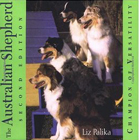
Click on the cover above
to go to this book
at Amazon.co.uk
|

The Australian Shepherd, Champion of Versatility
Liz Palika
John Wiley & Sons; 2nd Edition (10 Oct 2003)
ISBN-10: 9780764541629
ISBN-13: 978-0764541629
ASIN: 0764541625
Australian shepherds are very attractive, long-coated dogs, which were
developed in the US, with some input from Spanish Basque sheep herding
dogs in their ancestry. Like all herders, they need physical exercise
and mental stimulation, or they can become difficult, and they can also
nip children, especially if the children are playing running games.
Supervision of herders and children is important, especially if your
child has friends round to visit. However, Australian shepherds are
quite gentle dogs, and can develop strong bonds with sensible children.
These dogs can be serious herders, but they also have a playful side
to their natures, which children can enjoy. Socialization is important
for Australian shepherds kept as pets, since they can be a little reserved
with strangers. Generally, so long as they are well-trained, and have
enough to do, they are well-behaved companions on walks, and can excel
in obedience, agility, herding and tracking. Many Aussies are in service
as search and rescue dogs as well as herders.
The main drawback of this breed is its vulnerability to health problems.
Australian shepherds can be long-lived if they are not afflicted by
inherited problems, which are, unfortunately, numerous, and include
seizures, cancer, allergies and skin disorders, heart, eye, and hip
problems, cancer, and hypothyroidism. It is especially important to
check on the ancestry of any pup you are interested in, and to ask how
long the pup's ancestors lived, and what health problems they may have
had. Diet is also important, given the breed's propensity to allergies.
Liz Palika's Australian Shepherd has some useful advice on training,
and on activities that you can enjoy with your dog. The book includes
a chapter by Ian Dunbar. There is also help with feeding, grooming,
and health issues. It's also a well-illustrated book, with lovely pictures
of Aussies.
 Top
of page Top
of page
|
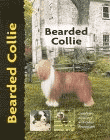
Click on the cover above
to go to this book
at Amazon.co.uk
|

Bearded Collie (Pet Love)
Bryony Harcourt-Brown
Interpet Publishing
ISBN: 1902389352
Bearded collies are very active, friendly dogs, which were developed
to work independently, so are not quite as obedient as border collies.
They need a fair bit of grooming, not as much as an Old English Sheepdog,
which they resemble somewhat, but they do need a good brush at least
once a week, and they tend to collect mud on their long coats. Beardies
have a habit of jumping up in order to greet you better, and they are
large dogs which can easily knock over small people as they rush past.
They are not really suitable for homes with frail, elderly people, or
toddlers, unless you can train them very strictly when they are pups.
They should also be trained not to nip as pups. They are usually much
less nippy than Border Collies, but a Bearded Collie that does nip is
much more difficult to control, because they are such fast movers. Well
trained Bearded Collies are usually fine with older children, because
they are so friendly and playful. They need a lot of exercise, but enjoy
retrieving, so can play happily for long periods in the garden. Beardies
are also good agility dogs and tend to enjoy agility, sometimes to the
extent of doing jumps twice, the second time just for fun. They usually
get on well with other dogs, though some dogs find them a bit large
and fast moving for comfort. It's easier to match them with a relatively
placid breed if you have more than one dog, since two dogs with very
high activity levels can be a little wearing! Bearded Collies can be
destructive if bored, tending to strew laundry and get into the rubbish.
They also bark more if bored. They are good watchdogs, since they give
good alarm barks, though they are then likely to kiss any intruder.
They are generally healthy, staying active throughout their lives, though
some common problems that the breed can suffer from include allergies,
hip dysplasia and hypothyroidism.
Bryony Harcourt-Brown gives a good description of the breed, with advice
on training and general care, as well as an account of the history of
Bearded Collies. This is a good introduction to the breed for a novice
Beardie owner, or someone considering a Bearded Collie.
 Top
of page Top
of page
|
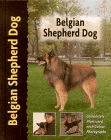
Click on the cover above
to go to this book
at Amazon.co.uk
|

Belgian Shepherd Dog (Pet Love)
Robert Pollet
Interpet Publishing
ISBN: 1903098564
Belgian Shepherd Dogs are becoming increasingly popular, though they
are still not very well known. They are an unusual breed with a lot
of character. Spitz lovers are likely to feel more at home with Belgian
Shepherds than with German Shepherds, since much of this breed's body
language is similar to that of a spitz. They come in four varieties.
The Groenendael is a long haired black breed and the Tervueren also
has a long coat, but is black and red or black and fawn, with the same
sort of colour distribution as a German Shepherd. Both these breeds
need grooming at least once a week, and they need collars which are
kind to their ruffs. The Malinois has similar colours to the Tervueren,
but has short hair, and can be mistaken for a German Shepherd, though
the body language is different, while the Laekenois is wiry-coated and
fawn. These dogs are increasingly used by police forces worldwide, especially
the Malinois, due the problems that have arisen from poor breeding of
German Shepherds. Like German Shepherd Dogs, Belgian Shepherds can be
over-protective, so they should be trained with care. They are naturally
good guard dogs, and should be socialized to be friendly with people
when they are pups. They can also be barky dogs, and it's a good idea
to teach them how to be quiet while they are pups, trying never to reward
barky behaviour and giving rewards, like opening the door to go out,
when they are quiet. They also need to understand from day one that
playbiting is not permitted.
Are Belgian Shepherd Dogs good with children? Generally, yes, so long
as they are well-socialized and well trained. This also applies to their
relations with other dogs - Belgian shepherds can be very playful with
those dogs they get on with, more playful than the average German Shepherd
Dog. They are quite capable of obeying their owners and ignoring a passing
dog on walks, though, even if the dog is a friend. Unsocialized Belgian
Shepherds can be dog-aggressive, as with any breed, but usually their
relations with other dogs are good.
Health problems include eye trouble, though generally this is a healthy
breed, especially compared with German Shepherd Dogs.
Robert Pollett has written a good, up-to-date guide to the breed, which
helps to understand the character of Belgian Shepherds, as well as giving
help with training. There is a lot of information on the history of
all four types of Belgian Shepherd Dog, and the book is well illustrated.
 Top
of page Top
of page
|
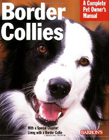
Click on the cover above
to go to this book
at Amazon.co.uk
|

Border Collies Complete Owners Manual
Michael DeVine
Barron's Educational Series Inc.,U.S.;
2nd Revised edition edition (29 Jun 2007)
ISBN-10: 0764136445
ISBN-13: 978-0764136443
Border collies are often described as workaholics. They like to be
kept busy, and can become difficult if they are bored. They are the
best breed for a number of activities, such as agility and flyball,
so much so, that owners of other breeds often don't want to compete
against border collies! They are also fine obedience dogs. Not everyone
is suited to being a BC owner. You need to be able to commit quite a
lot of time to the dog, or use a BC as a working dog, herding sheep.
They are the best herders, heading off stray sheep and keeping the flock
together, taking it to where the owner commands. People who watch sheep
trials on TV may want one of these magic dogs, but it takes a lot of
training to get a BC to that stage, and untrained Border Collies are
just as likely to harass sheep as any other dog, perhaps more so, because
of their herding drive. Herding is a very enjoyable activity for people
who have the time to learn with their dogs. It's best learnt from someone
who has a lot of experienced of herding with Border Collies, since the
skill involves a lot of non-verbal elements, like 'reading' the dog,
getting the timing right, and developing signals that you can use at
a distance. Luckily, Border Collies also have a strong retrieving drive,
and you can keep them happy for hours bringing back balls in your garden.
You need to teach them how to retrieve, starting out with a lot of balls,
and praising them when they bring one back, throwing it again. They
have the potential as retrievers, but aren't born knowing how to, they
just learn very fast, and don't want to stop once they have learnt.
It's a good idea to make ball playing a proper game, getting the collie
to sit and stay while you throw the ball, only retrieving after you
have said 'fetch', and bringing back the ball to you ending in a nice
sit, presenting the ball in their mouths. You also need a command that
says 'no more ball throws'. Training retrieves properly, rather than
just throwing balls, allows you to have more control. Otherwise, Border
Collies are prone to trying to grab the ball from your hand, and pestering
you for games all the time.
Border Collies are 'velcro dogs', tending to follow you to the bathroom,
and watching you in the hope you might do something interesting. Some
people describe them as always asking 'What do you want me to do now'?,
like a very keen employee. Others see them as wanting their owners to
entertain them as much as possible. Either way, you have to accept that
a Border Collie is likely to want a very intense relationship with you,
and you have to learn how to 'turn a Border Collie off', since they
will carry on working or playing for as long as you interact with them.
Are they good with kids? Not always, it has to be admitted. Border
collies are essentially working, rather than pedigree dogs, and their
temperaments vary enormously. Some are wonderful with kids, while others
can be nippy and nervous. However, kids who understand dogs can get
on fine with them, and have happy hours together with a BC, especially
if the kids can play ball, and impose strict rules, such as getting
the dog to sit before the ball is thrown. They vary in terms of how
well they get on with other dogs, but generally are more interesting
in playing ball with their owners than going and socializing with dogs
they meet on walks.
Common health problems include hip dyplasia and eye trouble. Eye problems
are so common with Border Collies it's best to check the ancestry of
any pup you are interested in, and ask specifically about eye problems.
Border Collies are also prone to playing retrieving games with such
intensity that they forget to wee, and can collapse from overexertion,
especially when it's hot, and wear down their pads until they are raw,
so you need to impose rest periods. Sound phobias are a common behavioural
problem, though the drive to work is so intense that you can sometimes
get a sound-phobic Border Collie to snap out of it, simply by giving
commands, or producing a ball from your pocket. So long as they have
something to do, their neuroses tend not to surface, which is why they
are called workaholics.
Michael De Vine's book is a very good introduction to the breed. It
covers the history of the breed, as well as general care, and various
activities that border collies can get involved in, as well as health
issues. It's also an amusing book in parts. It's more of a general introduction
for novices than a book for experienced owners, but is certainly one
of the best.
 Top
of page Top
of page
|

Click on the cover above
to go to this book
at Amazon.co.uk
|

The Ultimate Border Collie
Ed Alison Hornsby
Ringpress Books
ISBN 1860540880
This book is a complete guide to border collies, with a lot of useful
information for owners. It covers origins and history, choosing and
raising pups, feeding, breed traits and training, obedience, agility,
flyball, herding, other work, breed standards and showing, breeding,
collies in different countries, and health and disease.
On the whole, this guide to collies is highly recommended. The chapters
on training and working collies give a very clear idea of what collies
are like, and what they can do. There is a lot of breed-specific information,
for example on their little behavioural quirks, their abilities and
vulnerabilities, including diseases associated with the breed.
Each chapter has been written by someone with expertise in that particular
field. This has great advantages because it means that each writer knows
what they are talking about. There is a disadvantage, however, in that
there is a lack of coherence in the book as a whole, which reflects
different ‘border collie cultures’. Part of the book focuses
on the performance of collies, what they can do, and part focuses on
what certain people have decided that collies should look like.
The main reason that most owners like border collies is for what they
can do. However, collies have a number of tendencies that make them
less than ideal pets for people who do not know the breed well, and
whose lifestyle and temperament do not fit well with the breed. Border
collies are sensitive, so can become sound-phobic and over-excited.
They can be nippy. And they need something to do. Put a collie in an
enclosed environment where it has no work, and is overstimulated by
loud noises and bright lights, and the dog will probably go mad. Border
collies often end up in shelters in the UK. People take them on without
knowing enough about their needs. Collies do not cope well with shelters,
which are about the worst possible environment for them. Being confined
in a noisy kennel is extremely stressful for a collie. Shelters need
to rehome these dogs fast, and it would help the breed if there were
a chapter on rescue in this book.
It would also be helpful if the chapter on breeding addressed the issue
of what the pups are for. The traits needed for a working dog, keenness,
responsiveness, which often comes with a tendency to be obsessive, are
not necessary those needed for a pet dog. It is far more important for
pet collies not to nip, or wreck the house if left alone, and to be
able to cope with a little less exercise than a working collie. Dogs
from working lines do not always make good pets. The chapter on breeding
focuses on producing show collies, whose main role is to look good.
This, for most owners, is the least important issue, especially with
this particular breed. Anyone breeding collies will want to place them
in good homes. This is not possible without asking what the dogs will
be for, and whether they are likely to have the right temperament to
be working dogs, or pets. This is a key issue, which the chapter on
breeding does not address.
This grumble apart, The Ultimate Border Collie is generally a real
treat for people who love collies, full of interesting facts as well
as useful information.
 Top
of page Top
of page
|
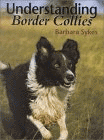
Click on the cover above
to go to this book
at Amazon.co.uk
|

Understanding Border Collies
Barbara Sykes
The Crowood Press;
ISBN 1861262809
This is an extremely useful book for Border Collie owners, because
it gives such a clear picture of the breed, the challenges that a Border
Collie can present, and is full of useful tips to help you deal with
those challenges. You may not agree with all Barbara Sykes' training
advice, but it is obvious that she loves the breed, tries to see life
from the dog's point of view, stresses common sense, and is results
oriented. You can pick and choose which of her training tips to incorporate
into your training repertoire. She links the breed's history very well
with the character of Border Collies. There is also very good advice
on general care, such as nutrition. The book is well set out, and easy
to read. It's very entertaining in parts, and there are many wonderful
illustrations. It's a must-read for Border Collie lovers.
 Top
of page Top
of page
|

Click on the cover above
to go to this book
at Amazon.co.uk
|

The Dog Wars
Donald McCaig
Outrun Press (1 April 2011)
ISBN-10: 0983484503
ISBN-13: 978-0983484500
"The Dog Wars" is the story of a battle by organizations representing owners of working Border collies to prevent the American Kennel Club (AKC) from "recognising" their breed. "Why the fuss?", you might ask. "Surely recognition from an influential body would bring benefits." Well, actually no, according to many breed organizations. For sheepdoggers, like Donald McCaig, the concern is that recognition brings pressures to breed dogs that conform to a particular appearance, the "conformation standard". Yet the essence of border collies lies in their ability to work. The ISDS, or International Sheepdog Society, will register dogs on merit, for their ability to work, regardless of their parentage or appearance. As anyone who has watched "One Man and His Dog" knows, Border collies come in all shapes, colours, coat types and sizes. A proposal to turn this particular breed into an attractive, but useless dog, conforming to just one particular appearance template for a collie, makes no sense. Border collies are dogs bred to do a particular job. Collies bred for appearance only are therefore not border collies, regardless of their pedigrees. Donald McCaig talks of this in terms of a religious war. Religion is about shared values and ethics, so in the eyes of people who love working border collies, breeding collies for appearance is sacrilege.
The AKC won its battle in December 1994, though most owners of American registered border collies opposed the move. How did the AKC manage to do this?
 Read more Read more
 Top
of page Top
of page
|

Click on the cover above
to go to this book
at Amazon.co.uk
|

The Pembroke Welsh Corgi (Happy,
Healthy Pet)
Debra M. Eldredge DVM
John Wiley & Sons; 2nd Edition edition (26 Jan 2009)
ISBN-10: 0470390611
ISBN-13: 978-0470390610
Corgis are potentially fine little companion dogs, as well as excellent
working dogs, but they are very high in the list of breeds likely to
be euthanased for behavioural problems. Why is this? They were bred
to herd cattle, and as such have a tendency to nip, hard. Teaching bite
inhibition is extremely important with pups of this breed. Corgis that
have been trained not to bite people when they are pups make good companions
for children, so long as the children don't roughhouse them, but treat
them with respect. Pembroke Corgis are also a very vocal breed, which
can be a disadvantage, though they do make good watchdogs. They aren't
especially sociable with other dogs, though they can get on well with
dogs in the same household, so long as they are well matched. They can
perform well as obedience dogs, and are excellent agility performers,
often the best in groups of small dogs. They have also been used as
tracker dogs. They love attention, and can get up to mischief if left
to their own devices for too long. Like all herding dogs, they need
an owner with commitment. Common health problems include a tendency
towards obesity, and they should be kept slim as pups, since fat pups
are more likely to have problems in later life.
Deborah Harper's introduction to the breed gives new owners a very
good idea of what to expect, and the illustrations are good. There is
also a lot of help with training, which is especially important with
this breed.
 Top
of page Top
of page
|

Click on the cover above
to go to this book
at Amazon.co.uk
|

Everything You Need to Know About German Shepherds
Joan Hustace
DAVID & CHARLES (26 May 2006)
ISBN-10: 0715324934
ISBN-13: 978-0715324936
German Shepherd Dogs have long been favourites in the UK. They are very versatile dogs, and play a number of roles, including helping disabled people, and working as police dogs. They are dogs that bond very strongly with their owners, and they can be trained more easily than most breeds, because they have a strong desire to please, though they are less 'forgiving' of mistakes in training than, say. Labrador retrievers. They can be reliable companions on walks, and tend to deter unwanted intruders with their deep barks and imposing presence. So, what's the downside? German Shepherds can be a bit too protective of their owners, and if you don't take control, they can try to control you. They can also be a bit territorial, and need to be taught that visitors have a right to come into your home. They also vary in terms of how relaxed they are. Some German Shepherds have a similar sort of intensity to that of Border Collies, while others are much more relaxed. A relaxed German Shepherd is a better bet for someone who is relatively inexperienced, or a family with children, and this means asking detailed questions of the breeder, as to what sort of temperament they are breeding for, and whether they think their line would suit you. If the breeder doesn't seem to know what you are talking about, chances are that it's not a very good breeder.
The big problem with German Shepherds is that they have all too often been bred with no thought for temperament or health. Anyone who knows a large number of German Shepherd Dogs will be familiar with the wide range of characters, from the very relaxed, calm, and outgoing dogs, to the nervy, snappy individuals who don't trust anyone other than their owners, and back off then snap when another human or dog comes near. The breed's temperament is improving as breeders have become more aware of the need to breed for a dog with steady nerves, but this problem means that many German Shepherds are nervous with children, despite socialization, though other individuals are very relaxed and tolerant with children. Anyone buying a German Shepherd puppy should always try to meet both parents, to see how relaxed they are. Rescue German Shepherds are easy to 'read' - the breed is one of the most expressive among dogs - and parents can take along children, to see how the dogs react to kids, without letting the children get too close. A good rescue centre should also be able to advise you on whether a particular German Shepherd will suit you.
Socialization is, of course, very important with this breed. They need to get to know a variety of friendly adults and children as they are growing up, in order to be outgoing and friendly as adult dogs. German Shepherd dogs that have been able to play with puppies of other breeds when they were pups are also much more likely to grow up into adults that behave well with other dogs.Socialization is, of course, very important with this breed. They need to get to know a variety of friendly adults and children as they are growing up, in order to be outgoing and friendly as adult dogs. German Shepherd dogs that have been able to play with puppies of other breeds when they were pups are also much more likely to grow up into adults that behave well with other dogs.
The breed also has a number of common health problems, such as hip dysplasia, arthritis, and digestive problems, so it's also important to ask about the longevity of the ancestors of any pup you are interested in. Rosettes for good looks are no guarantee that the parents are good breeding material. They tell you little about a dog's temperament, and tend to be awarded to young adult dogs, before diseases of middle age set in. Ask the breeder about the line, the grandparents, great grandparents, what they were like and how long they lived. You may feel hesitant about sounding rude, but it can save you a lot of heartache later if you do a thorough check on the pup's ancestry. Other disadvantages of this breed are that they can shed a lot more than you expect, especially during their spring moult, and they can be quite barky, especially if left alone a lot.
German Shepherds tend to do best with owners who are experienced with dogs, and who have a lifestyle that allows them to give the dog some stability and order. These dogs tend to worry about their owners and the state of the world if their schedules suddenly vary. This is not an ideal breed for a novice owner, though German Shepherds have huge appeal for their trainability and reliablity, and many people would own no other breed.
Joan Hustace's book is a very good introduction to the breed, and gives help with all stages of the dog's life, from choosing and caring for a pup, to feeding, grooming and training. The book takes a common-sense approach, which is especially helpful fornew owners. There is a lot in this book that particularly refers to German shepherds, so experienced owners are likely to learn something from it too.
 Top
of page Top
of page
|
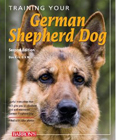
Click on the cover above
to go to this book
at Amazon.co.uk
|

Training Your German Shepherd Dog
Dan Rice
Barron's Educational Series Inc.,U.S.; 2nd Revised edition edition (1 Oct 2010)
ISBN-10: 0764143204
ISBN-13: 978-0764143205
It's very important for owners of German Shepherds to learn about training.
Dogs of this breed have great potential for learning, but this means
that they can easily pick up bad habits. They are also sometimes too
nervous to do well in dog clubs, where they have to cope with a lot
of other dogs and people in close proximity. Dan Rice has written a
clear guide to help owners get the best from their dogs. which is well
illustrated with photographs to help you follow his tips. Children should
be able to follow his advice, so you can involve all the family in your
dog's training regime.
 Top
of page Top
of page
|
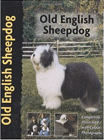
Click on the cover above
to go to this book
at Amazon.co.uk
|

Old English Sheepdog
Ann Arch
Interpet Publishing (1 April 2000)
ISBN-10: 1902389379
ISBN-13: 978-1902389370
Old English Shepherds are playful, strong-willed, versatile dogs, which need a lot of grooming. They need a lot of commitment because they can be a handful if not properly trained, and if they don't get enough exercise. They are at higher risk of being euthanased for behavioural problems than Jack Russell Terriers. A large breed dog can create more havoc when things go wrong! Perhaps one problem is that they look such cuddly dogs, and make people laugh when they clown. It's too easy to let them get away with things they shouldn't really do when they are pups, and by the time they get to be big, bouncy, powerful dogs, it's much more difficult to train them. They are also dogs that were used to help drovers take sheep and cattle to market, so if you don't tell them what to do, they will tend to try to herd you and anyone else they think needs pointing in the right direction. They need to be trained in house rules from the day they arrive in your home, and they do train well as pups. Old English Sheepdogs are intelligent, and want to be entertained by their owners, so they can find training enjoyable. They have learnt to play a number of roles and take part in different activities, including agility, herding and search and rescue, and they can perform well in obedience competitions. They need both mental stimulation and physical exercise, and dogs that are just let out to play in the garden in the evening, and are shut up all day while you are out at work can rearrange your house for you in ways you would rather they didn't, just out of boredom. They do enjoy games, such as 'hunt the titbit', which you can play with them at home if you are too tired to go for a long walk and your dog is bored, and you can play active games with them in your garden, but generally they benefit from a long walk every day.
Are they good with children? Well-trained Old English Sheepdogs can be excellent companions with children, though this breed does take some time to mature, and younger dogs are often a little too large and bouncy for smaller children. They way they behave with other dogs varies. They can be very good playmates with some of the larger, more robust and playful breeds, but they do need careful socialization as pups, since some individuals can be dog aggressive.
The biggest downside of the breed is perhaps the need for a lot of grooming, since Old English Sheepdogs have a distressing tendency to mat unless groomed very frequently. Mats are difficult to remove, once they form, and sometimes have to be shaved off. You will benefit from a session with a groomer, who can show you how to groom your dog, because it takes a lot of patience. Little and often is the secret, since if you let the mats develop, grooming becomes an ordeal for you and your dog. Some people trim the dogs' coats, which makes grooming a lot easier. Old English Sheepdogs have a double coat, and are well protected against the weather. They can stand the cold well, but have to be protected from the heat in summer, and should not be allowed to run around too much in the hot sun, or be left where they have no access to shade. They aren't especially bad shedders, so long as they are groomed regularly.
This breed can be very barky, though it is less of a problem if they get enough exercise. They have a deep bark, which can be useful to deter unwanted visitors. Some can be protective, while others can be very friendly when an unaccompanied visitor comes into the home, after having given a deep 'Woof', and this friendliness can apply to burglars!
Common health problems include hip dysplasia and eye trouble. You also need to be careful with their nutrition while they are growing pups, when they tend to eat a lot. Like all long-coated breeds, it is often difficult to tell whether they are too fat or too thin, so it's a good idea to feel for the ribs and backbone, and try to work out the ideal weight for the dog, then weigh the dog regularly, for example every week. Their food requirements will fluctuate while they are growing - young dogs often go through dormant phases when they don't eat much, then eat more, but their needs will become more stable when they become adults, with more food needed when they are active, and it's cold, and less needed when it's hot and when they are not so active.
This guide to the breed covers the breed history, temperament, choosing a puppy, training, feeding, grooming, and showing old English sheepdogs. There is also useful advice on preventative health care, and puppy-proofing your home important with such a large, bouncy breed. Lastly, there is help with caring for oldsters. The book is clearly written, with enough information to interest experienced owners as well as novices. The book is also well-illustrated, with more than 135 colour photos.
 Top
of page Top
of page
|
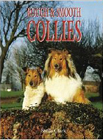
Click on the cover above
to go to this book
at Amazon.co.uk
|

Rough and Smooth Collies (Book of the Breed)
Stella Clark
Ringpress Books
ISBN: 0948955821
Rough Collies became popular with Lassie, and this is one case where
popularity in a movie has tended to have a happy outcome. Rough Collies
are good family dogs, usually getting on very well with children. They
are certainly a far more biddable breed than Dalmations, though they
can develop bad habits if they don't get enough exercise and aren't
trained properly. They are sensitive dogs, and learn well, so long as
their owners are patient. They will tend to shut off if they are shouted
at. They have been used in a number of roles, including herding, search
and rescue, and helping disabled people. Rough Collies are also generally
outgoing and friendly and tend to get on well with other dogs. One reason
they may get on so well with people is that they are so good looking
with their long coats, that every passer by wants to pet them, and Rough
Collies love this attention.
Smooth Collies are very similar to Rough Collies in terms of character,
without the long hair, but they can be a little nervy and shy, and so
may need a very gentle but firm approach to training, with no playbiting
allowed when they are little so that they are less likely to snap from
fear when they are older. It's especially important to check the temperament
of Smooth Collie parents of any pup you are interested in.
What is the downside of Rough Collies? They are herders, so do need
exercise and mental stimulation, preferably daily walks with their owner.
They also need a lot of grooming, with at least one good grooming session
every week, or they tend to mat. Many people prefer Smooth Collies because
they don't need so much grooming, taking care to choose pups from parents
with very good temperaments. Some rough collies can be nervy and a bit
over sensitive too, and they can also be very barky.
Common health problems include skin disorders, which are partly hereditary,
and can be affected by food and environmental chemicals, and possible
sensitivity to some veterinary pharmaceutical products. Eye trouble
can also be inherited.
This is a good introductory guide to Rough and Smooth Collies, covering
their history and general care, including grooming and training.
 Top
of page Top
of page
|
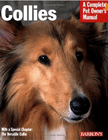
Click on the cover above
to go to this book
at Amazon.co.uk
|

Collies, Complete Pet Owner's Manual
H. and M. Sundstrom
Barron's Educational Series Inc.,U.S.; Revised edition (26 Aug 2005)
ISBN-10: 0764128590
ISBN-13: 978-0764128592
This is a short, introductory guide to collies, which is very good value, and gives a clear idea of what collies are capable of. It is clearly written, and the photos are lovely. This would make a good present for a child, though a meatier book is perhaps more suitable for an adult wanting to know more about their breed.
 Top
of page Top
of page
|
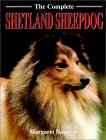
Click on the cover above
to go to this book
at Amazon.co.uk
|

The Complete Shetland Sheepdog
Margaret Norman
Ringpress Books Ltd (Dec 1998)
ISBN-10: 1860541305
ISBN-13: 978-1860541308
Shetland Sheepdogs are like smaller versions of Rough Collies, and
are very similar in character, though some can be nervy, and they tend
to be noisier. It's a good idea to check out the temperament of a pup's
parents, since these dogs do vary in terms of temperament. They are
a little delicate for families with children, though they can get on
very well with sensible children who respect them. Shetland Sheepdogs
are especially suitable for people with experience of dogs who want
a smaller breed which likes exercise and is not likely to pull you over
on walks. They are popular among retired people who feel they no longer
have the strength for a bouncier, larger dog. They are responsive dogs,
so can be very rewarding with owners who have time to spend on them.
Shelties are versatile, and can perform well in obedience competitions,
as well as enjoying a range of activities. They are less likely to bark
and develop other undesirable habits if they have enough to do. They
benefit from a daily walk, and enjoy playing games indoors if it's too
unpleasant outside for more than a short walk.. These are not dogs to
choose because they are cute, and look like they are small enough to
live in a flat. They need exercise and mental stimulation, like any
herder, and they also need daily grooming, to look their best. Common
health problems include those common to Rough Collies, such as eye trouble,
as well as digestive problems.
This is a good introductory guide to Shetland Sheepdogs by someone
who clearly loves the breed. Their history is covered, and there is
a good portrait of their character, as well as useful advice on general
care and training.
 Top
of page Top
of page
|
See also:
 Dogs:
Breed profiles and breed books Dogs:
Breed profiles and breed books
 Dogs:
Health and Nutrition Dogs:
Health and Nutrition
 Dogs:
General Dogs:
General
 Dogs:
Origins, canine evolution and wolves Dogs:
Origins, canine evolution and wolves
 Training, puppy and adult dog good manners Training, puppy and adult dog good manners
 Dogs: Skills training: Agility and training games Dogs: Skills training: Agility and training games
 Dogs: Skills training:Sheepdog, gundog and scent work Dogs: Skills training:Sheepdog, gundog and scent work
 Fiction
and biography relating to dogs Fiction
and biography relating to dogs
|